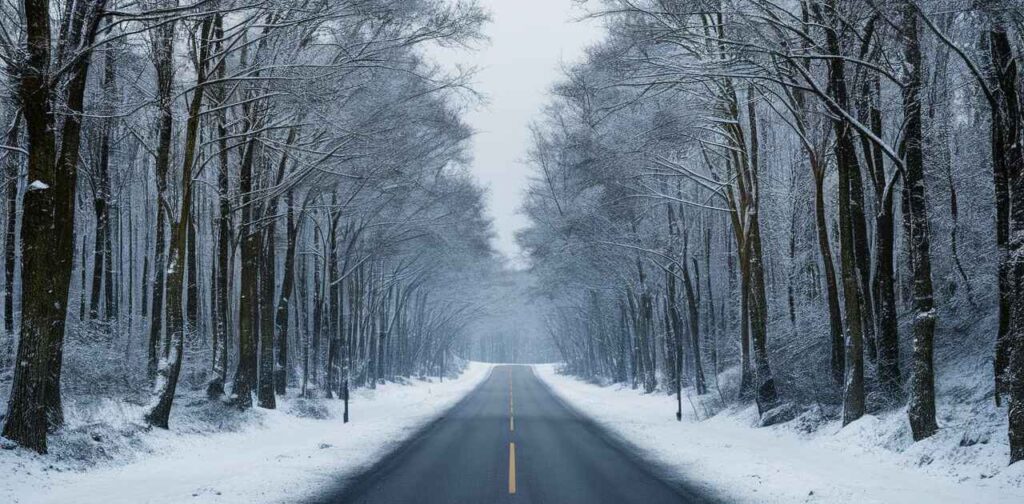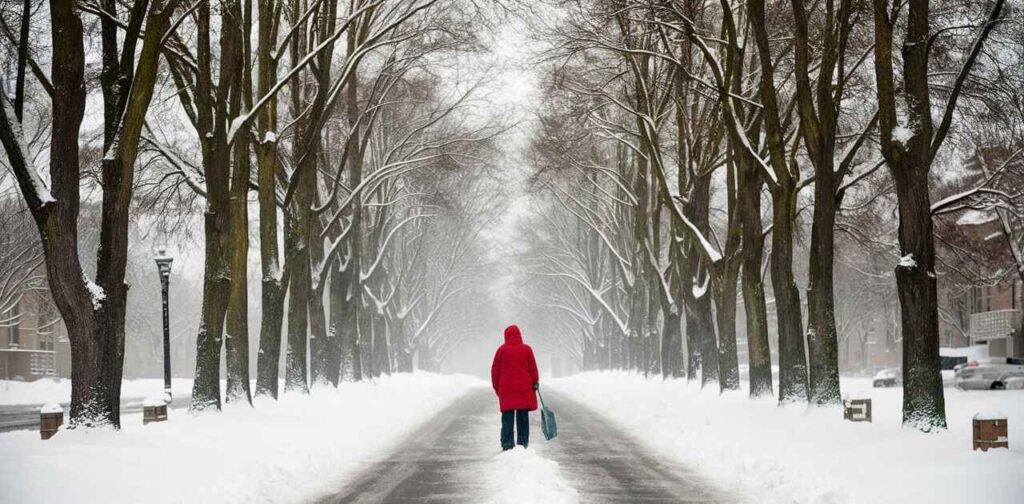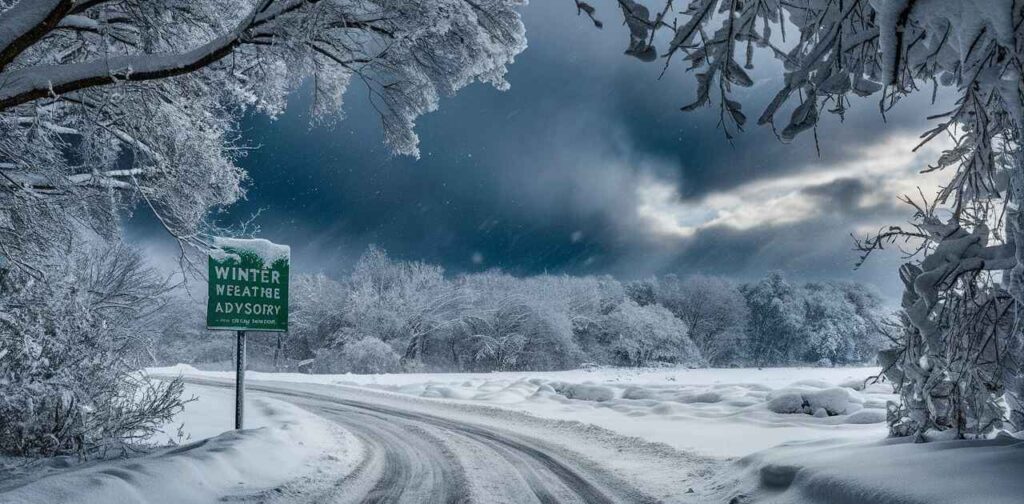Hey there, Northlanders! Brace yourselves winter’s about to show its frosty face in a big way.
A Winter Weather Advisory has just been issued for Northern Minnesota and Northwest Wisconsin. But what does that mean exactly?
Simply put, it’s a heads-up from the National Weather Service that we’re in for some challenging winter conditions. We’re talking snow, wind, and chilly temperatures that could make daily life a bit tricky.
So, what’s coming our way? Expect heavy snowfall, gusty winds, and slippery roads. It’s time to dust off those winter boots and prep for some serious snow days.
Ready to learn how to weather this storm? Let’s dive in!
What’s Brewing in the Forecast?
The National Weather Service has issued a Winter Weather Advisory for our neck of the woods, and it’s not just a dusting we’re talking about. We’re looking at a potent mix of heavy snowfall and gusty winds that’s set to hit us starting tomorrow evening and lasting through Friday morning.
Here’s what the meteorologists are predicting:
- Snow accumulation: 6-10 inches in most areas, with up to 12 inches possible in higher elevations
- Wind gusts: Up to 35 mph, causing blowing and drifting snow
- Temperatures: Dropping to the low teens, with wind chills near zero
Now, I know what you’re thinking “That doesn’t sound too bad. We’ve seen worse, right?“ True, but remember, it’s not just about the amount of snow. It’s the combination of snow, wind, and cold that can really throw a wrench in our plans.
Affected Areas: Where Winter’s Grip Will Be Strongest
So, where exactly is this winter weather advisory in effect? If you’re in these areas, it’s time to pay extra attention:
- Northern Minnesota: Including Duluth, Grand Marais, and International Falls
- Northwest Wisconsin: Covering Superior, Ashland, and Bayfield
But don’t think you’re off the hook if you’re just outside these areas. Weather doesn’t follow city limits, so surrounding regions should also be on alert for challenging conditions.
Potential Effects of Winter Weather: What to Watch Out For
Now, let’s talk about what this weather could mean for our daily lives. It’s not just about having to shovel more snow (though there will be plenty of that!).
Road Conditions
Slick and Treacherous Expect roads to become slippery and snow-covered quickly. Those gusty winds we mentioned? They’ll be whipping up snow, reducing visibility and making driving a real challenge. If you absolutely must travel, pack your patience – and your emergency kit.
Power Outages
A Real Possibility With strong winds and heavy snow, there’s a chance we could see some power outages. Trees laden with snow can come down on power lines, leaving us in the dark and cold. It’s a good reminder to have those flashlights and batteries ready!
School and Business Closures
Keep an ear out for announcements. There’s a good chance schools might opt for a snow day or two, and some businesses might decide to close up shop for safety reasons.
Also, read this interesting blog:
Seth B. Taube: Entrepreneur, Humanitarian, And Innovator
How to Prepare for the Winter Season: Your Action Plan

Alright, now that we know what’s coming, let’s talk about how to get ready. Think of this as your winter weather checklist – let’s tackle it together!
1. Insulate Your Home: Keep the Warmth In
First things first; let’s make sure your home is ready to stand up to the cold. Here’s what you can do:
- Check for drafts around windows and doors. Feel a breeze? Time for some weatherstripping or caulk.
- Take a peek in your attic. Is your insulation up to snuff? Adding an extra layer can make a big difference in keeping your home warm and your energy bills down.
- Don’t forget about pipes in exterior walls. A little insulation here can prevent a big headache later.
2. Service Your Heating System: Stay Warm and Safe
Your heating system is about to work overtime. Give it some TLC:
- Schedule a check-up with a pro if you haven’t already this season.
- Replace those furnace filters – clean filters mean an efficient system and better air quality.
- If you use a fireplace or wood stove, make sure your chimney is clean and in good repair.
3. Stock Up on Winter Supplies: Be Your Own Grocery Store
Imagine being stuck at home for a few days. What would you need? Here’s a starter list:
- Non-perishable food: Think canned goods, granola bars, and anything that doesn’t need cooking
- Water: One gallon per person per day is a good rule of thumb
- Medications: Make sure you have enough to last a week, just in case
- Batteries and flashlights: Because fumbling in the dark is no fun
- First aid kit: Hope you won’t need it, but better to have it
4. Prepare Your Vehicle: Your Car Needs Winter Gear Too
If you absolutely must venture out, make sure your car is ready:
- Snow tires or chains: These can make a world of difference on slippery roads
- Emergency kit: Include blankets, snacks, water, and a phone charger
- Full tank of gas: Don’t let that gauge dip below half full
- Battery check: Cold weather is tough on batteries – make sure yours is up to the challenge
5. Protect Your Pipes: Prevent a Frozen Disaster
Frozen pipes can lead to burst pipes, and nobody wants that mess. Here’s how to prevent it:
- Let faucets drip: A small trickle can prevent freezing
- Open cabinet doors: This lets warmer air circulate around pipes
- Seal up cracks: Any opening to the outside is a potential freeze point
6. Practice Fire Safety: Stay Warm, Stay Safe
With everyone cranking up the heat, fire safety becomes extra important:
- Check smoke and carbon monoxide detectors: Make sure they’re working and have fresh batteries
- Keep space heaters away from anything flammable: Give them at least 3 feet of space
- Never use your oven to heat your home: It’s dangerous and inefficient
7. Stay Informed: Knowledge is Power (and Safety)
Staying on top of the latest weather updates can help you make smart decisions:
- Download a reliable weather app: Get alerts right on your phone
- Follow local news and weather stations on social media: They often post quick updates
- Know your emergency numbers: Save them in your phone for quick access
Community Matters: Looking Out for Each Other

Remember, we’re all in this together. As we brace for this winter weather, let’s not forget about our neighbors, especially the elderly or those with mobility issues. A quick check-in could make a big difference.
- Offer to help with snow shoveling if you’re able
- Share extra supplies if you have them
- Spread the word about the weather advisory to those who might not be as connected
After the Storm: What’s Next?
Once the snow stops falling and the wind dies down, we’re not out of the woods yet. Here’s what to keep in mind:
- Take it slow when venturing out – there might be ice under that snow
- Check on your property for any damage from snow or wind
- Help clear sidewalks and driveways, but don’t overdo it – snow shoveling can be strenuous
Wrap Up
Heads up, folks! A Winter Weather Advisory is in effect for Northern Minnesota and Northwest Wisconsin. We’re looking at heavy snow, strong winds, and frigid temps. Time to prep your homes, cars, and emergency kits. Stay safe on those icy roads and keep an eye on your neighbors. Remember, we’re in this together. Bundle up, stay informed, and let’s show Old Man Winter what we’re made of. With the right preparation, we’ll weather this storm just fine. Stay warm and cozy, Northlanders!
FAQ’s
What is the winter weather prediction for Minnesota?
Minnesota is expecting significant snowfall and strong winds in the coming days. A Winter Weather Advisory has been issued, predicting 6-10 inches of snow in most areas, with up to 12 inches possible in higher elevations. Wind gusts up to 35 mph are expected, causing blowing and drifting snow. Temperatures will drop to the low teens, with wind chills near zero.
Will it be a snowy winter in Wisconsin?
While long-term predictions can vary, the current Winter Weather Advisory suggests that Northwest Wisconsin is in for a snowy spell. The advisory predicts heavy snowfall and gusty winds, indicating at least one significant snow event. For the rest of the winter, it’s best to stay tuned to local weather forecasts for the most up-to-date information.
What months does it snow in Wisconsin?
Wisconsin typically experiences snowfall from November through April, with the heaviest snow usually occurring in December, January, and February. However, it’s not uncommon to see snow as early as October or as late as May, especially in northern parts of the state.
What was the worst blizzard in Minnesota?
The Halloween Blizzard of 1991 is often considered one of the worst blizzards in Minnesota’s history. It dumped up to 37 inches of snow in some areas, paralyzed the Twin Cities, and caused widespread power outages. The storm lasted from October 31 to November 3 and set records for the largest single storm snowfall totals in many areas of the state.
Does snow fall in Minnesota?
Yes, snow is a regular part of Minnesota winters. The state averages about 70 inches of snow annually in the northeast, 55 inches in the southeast, and 40 inches in the southwest. The Twin Cities area typically receives around 55 inches of snow per year.
Are Minnesota winters getting colder?
Climate data shows that Minnesota winters have actually been warming on average over the past few decades. However, this doesn’t mean cold snaps and severe winter storms won’t occur. Climate change can lead to more extreme and unpredictable weather patterns, which might include both unusually warm periods and intense cold spells during the winter months.
Read more related interesting blogs
S&P 500 Analysis With FintechZoom: Optimize Investments 2024
Unanswered Questions: The Shooting Of Officer Dylan Hustosky By His Wife Kayleigh
Hey, Molar is the voice behind this all-encompassing blog, sharing expert insights and practical advice on business, real estate, and more. Dedicated to helping you navigate the complexities of these fields, Kelly provides the latest trends, in-depth analyses, and creative strategies to elevate your ventures.
